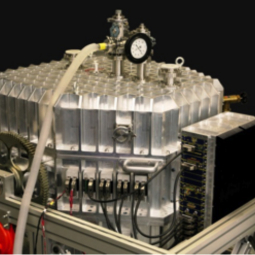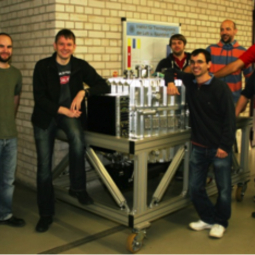The Field-Imaging Far-Infrared Line Spectrometer (FIFI-LS) instrument was shipped from Germany on November 11th, 2013. After the instrument arrived at the Dryden Aircraft Operations Facility, Palmdale, Calif., several months of preparations began for its operation onboard SOFIA. The first science observing flights with FIFI-LS are currently scheduled for March 2014. Being a so-called 3-D spectrometer, FIFI-LS uses SOFIA’s valuable observing time in a quite efficient way by obtaining images and spectroscopic information simultaneously using a rather complicated mirror system (Fig. 2b). Only the huge amount of information gathered by FIFI-LS may allow astronomers to identify and understand particular physical processes in the universe. Working at a wavelength range between 45 and 210 microns, the instrument can investigate the interstellar medium and star formation regions in our Milky Way as well as in other nearby galaxies.
FIFI-LS was originally developed by the Max-Planck-Institut Für Extraterrestrische Physik in Garching (MPE) under the leadership of Albrecht Poglitsch, but was transferred to Alfred Krabbe’s group at the Institute for Space Systems (IRS) of the Universität Stuttgart in September 2012. During the past few years project manager Sebastian Colditz and his team finalized, integrated and aligned the last optical components in the SOFIA laboratory facility of the Baden-Württemberg Space Center before the completed instrument was transformed into flight-certified hardware. In the most extreme case FIFI-LS might have to endure nine times the force of gravity on Earth’s surface, hence NASA has quite high flight safety requirements that must be fulfilled.
FIFI-LS was cooled seven times by liquid nitrogen and helium down to a temperature of minus 271°C to test all components under operating conditions.
For the last two weeks of October, Colditz and his colleagues were quite busy: some last plugs had to be brazed, screws had to be tightened again, and finally the instrument and some laboratory equipment had to be stored safely for transportation. On October 29th the so called “Pre-shipment Review Board“ led by the Germans Aerospace Center (DLR) declared: all-clear! FIFI-LS is ready for shipment to California. All in all, about two tons were sent to California, where they arrived the last week of November.
Principal investigator (PI) Alfred Krabbe and his colleagues will be rather busy conducting final tests on the ground as well as onboard SOFIA to make FIFI-LS ready for its first flight onboard the airborne observatory. The first commissioning flights for FIFI-LS on board of SOFIA are currently scheduled for February 2014 and the instrument will have “first light”.
SOFIA is a joint project of NASA and the German Aerospace Center (DLR). The aircraft is based at the Dryden Aircraft Operations Facility in Palmdale, Calif. NASA Dryden Flight Research Center manages the SOFIA program. NASA Ames Research Center at Moffett Field, Calif., manages SOFIA science and mission operations in cooperation with the Universities Space Research Association (USRA) headquartered in Columbia, Md., and the German SOFIA Institute (DSI) at the University of Stuttgart.
Points of Contact
Dörte Mehlert,
mehlert@dsi.uni.stuttgart.de
;
Sebastian Colditz,
colditz@irs.uni-stuttgart.de







